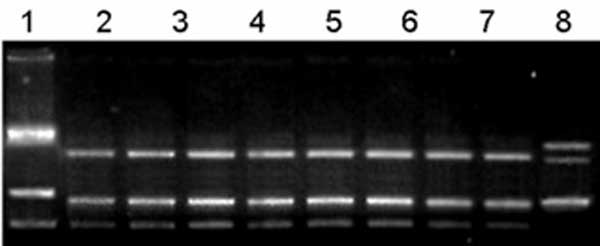Volume 11, Number 12—December 2005
Dispatch
Passatempo Virus, a Vaccinia Virus Strain, Brazil
Figure A3

Figure A3. Restriction fragment length polymorphism analysis of the ati gene of viral isolates. ati fragments were amplified by polymerase chain reaction by using primers based on the cowpox virus ati gene nucleotide sequence, followed by XbaI digestion. The amplified DNA was fractionated by electrophoresis on a 1% agarose gel and stained with ethidium bromide. Lanes: 1, vaccinia virus WR; 2, isolate-cow1; 3, isolate-cow2; 4, isolate-cow3; 5, isolate-cow4; 6, isolate-cow5; 7, isolate-calf; 8, cowpox virus BR.
Page created: February 02, 2012
Page updated: February 02, 2012
Page reviewed: February 02, 2012
The conclusions, findings, and opinions expressed by authors contributing to this journal do not necessarily reflect the official position of the U.S. Department of Health and Human Services, the Public Health Service, the Centers for Disease Control and Prevention, or the authors' affiliated institutions. Use of trade names is for identification only and does not imply endorsement by any of the groups named above.